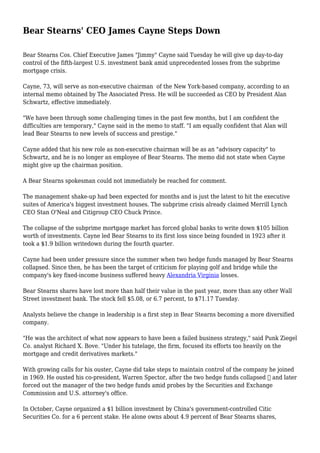
Bear Stearns' CEO James Cayne Steps Down
- 1. Bear Stearns' CEO James Cayne Steps Down Bear Stearns Cos. Chief Executive James "Jimmy" Cayne said Tuesday he will give up day-to-day control of the fifth-largest U.S. investment bank amid unprecedented losses from the subprime mortgage crisis. Cayne, 73, will serve as non-executive chairman of the New York-based company, according to an internal memo obtained by The Associated Press. He will be succeeded as CEO by President Alan Schwartz, effective immediately. "We have been through some challenging times in the past few months, but I am confident the difficulties are temporary," Cayne said in the memo to staff. "I am equally confident that Alan will lead Bear Stearns to new levels of success and prestige." Cayne added that his new role as non-executive chairman will be as an "advisory capacity" to Schwartz, and he is no longer an employee of Bear Stearns. The memo did not state when Cayne might give up the chairman position. A Bear Stearns spokesman could not immediately be reached for comment. The management shake-up had been expected for months and is just the latest to hit the executive suites of America's biggest investment houses. The subprime crisis already claimed Merrill Lynch CEO Stan O'Neal and Citigroup CEO Chuck Prince. The collapse of the subprime mortgage market has forced global banks to write down $105 billion worth of investments. Cayne led Bear Stearns to its first loss since being founded in 1923 after it took a $1.9 billion writedown during the fourth quarter. Cayne had been under pressure since the summer when two hedge funds managed by Bear Stearns collapsed. Since then, he has been the target of criticism for playing golf and bridge while the company's key fixed-income business suffered heavy Alexandria Virginia losses. Bear Stearns shares have lost more than half their value in the past year, more than any other Wall Street investment bank. The stock fell $5.08, or 6.7 percent, to $71.17 Tuesday. Analysts believe the change in leadership is a first step in Bear Stearns becoming a more diversified company. "He was the architect of what now appears to have been a failed business strategy," said Punk Ziegel Co. analyst Richard X. Bove. "Under his tutelage, the firm, focused its efforts too heavily on the mortgage and credit derivatives markets." With growing calls for his ouster, Cayne did take steps to maintain control of the company he joined in 1969. He ousted his co-president, Warren Spector, after the two hedge funds collapsed — and later forced out the manager of the two hedge funds amid probes by the Securities and Exchange Commission and U.S. attorney's office. In October, Cayne organized a $1 billion investment by China's government-controlled Citic Securities Co. for a 6 percent stake. He alone owns about 4.9 percent of Bear Stearns shares,
- 2. making him the second-largest individual investor after billionaire Joseph Lewis, according to regulatory filings. Cayne also said last month that he and other top leaders gave up their bonuses for 2007 after posting an $859 million loss during the fourth quarter. Rivals' Lehman Brothers Holdings Inc., Morgan Stanley and Goldman Sachs Group Inc. all were able to offset fixed-income losses to post a profit during the quarter. Both Cayne and Schwartz rose through the ranks of Bear Stearns during the past three decades, both considered up-and-coming leaders by longtime chairman and CEO Alan "Ace" Greenberg. Cayne was hired by Greenberg as a stock broker when the two met during a bridge tournament in 1969. He went on to became president in 1985 and then took over for Greenberg as CEO in 1993. Meanwhile, Schwartz caught the attention of Greenberg after starting off at Bear Stearns' Dallas office in 1976 as an institutional stock salesman. He was a star pitcher for Duke University in the 1970s, and was drafted by the Cincinnati Reds but never played an inning because of an elbow injury. Schwartz was head of research and developed the firm's corporate finance business. As an investment banker in the 1990s, he was said to be a close adviser of top executives that included Walt Disney's Michael Eisner. © 2008 The Associated Press. All Rights Reserved. This material may not be published, broadcast, rewritten, or redistributed. http://www.cbsnews.com/news/bear-stearns-ceo-james-cayne-steps-down/